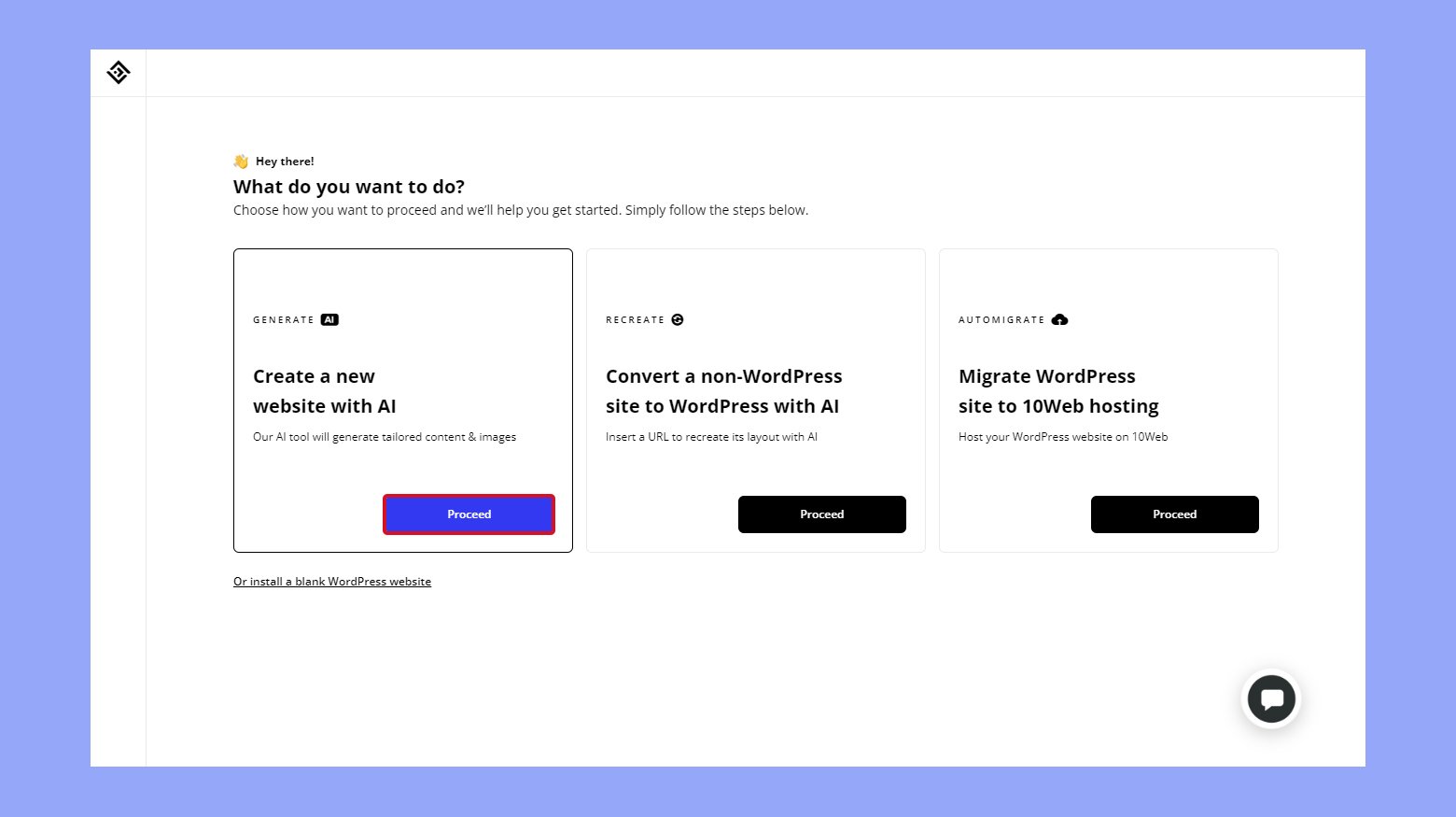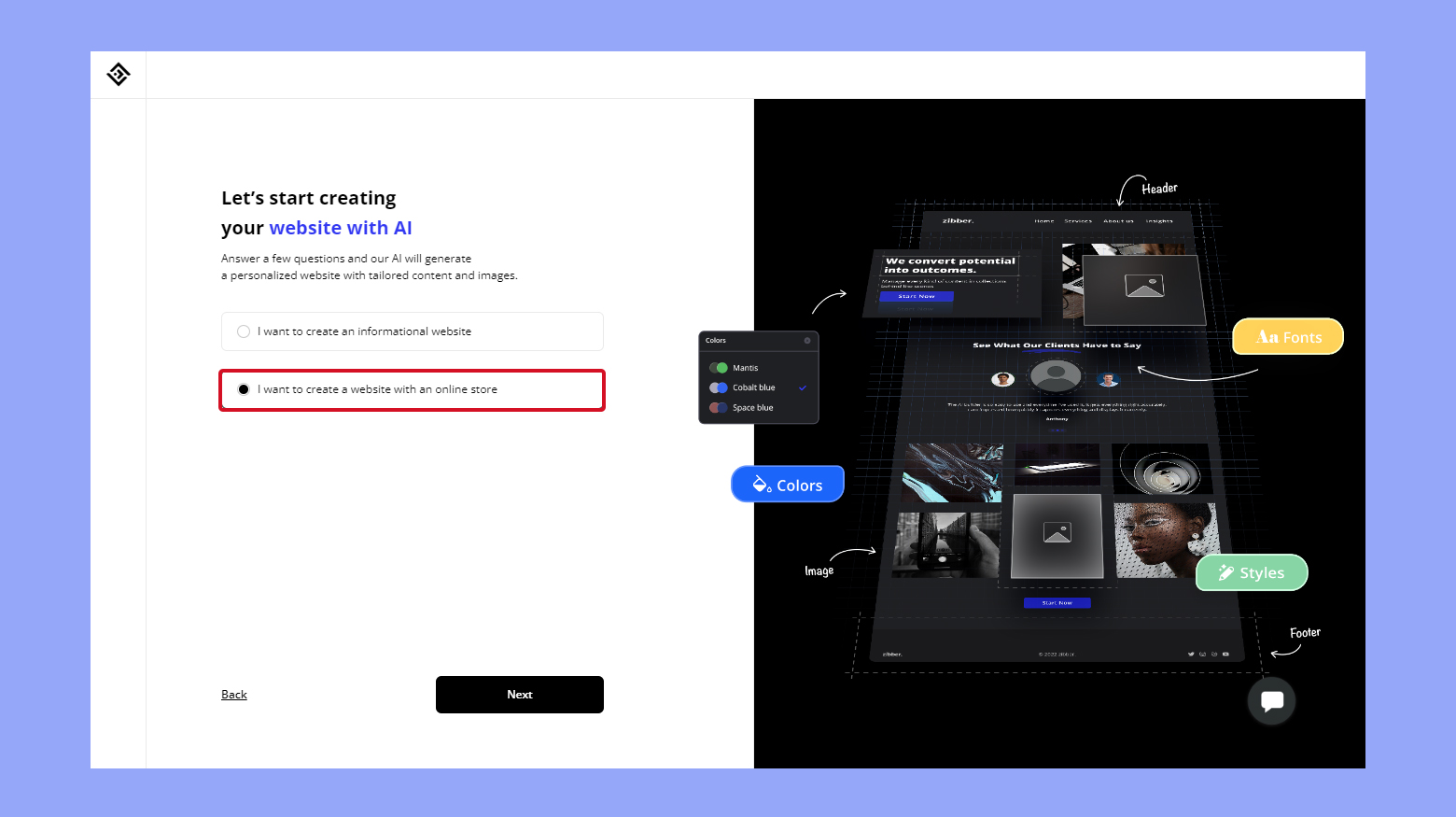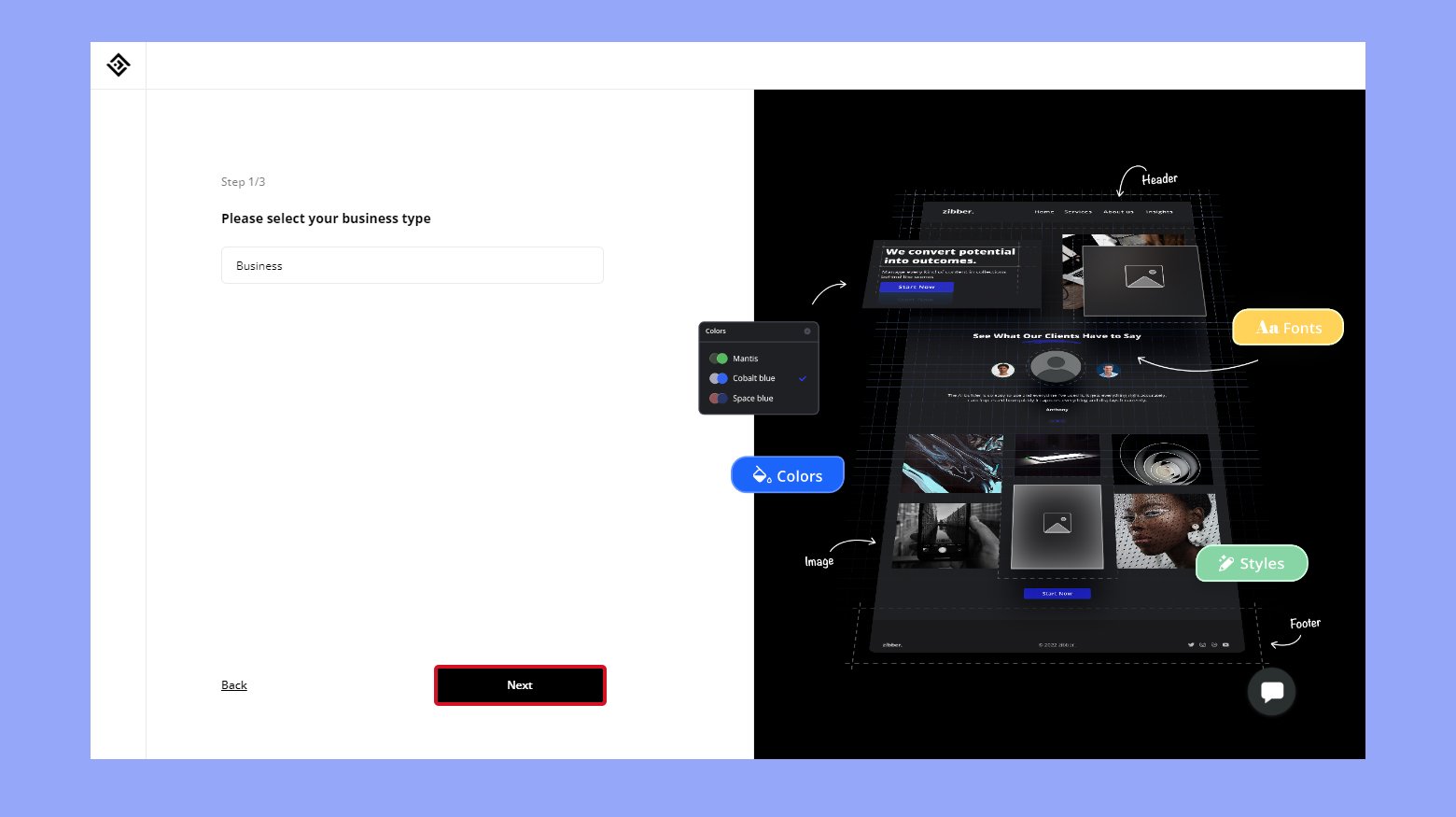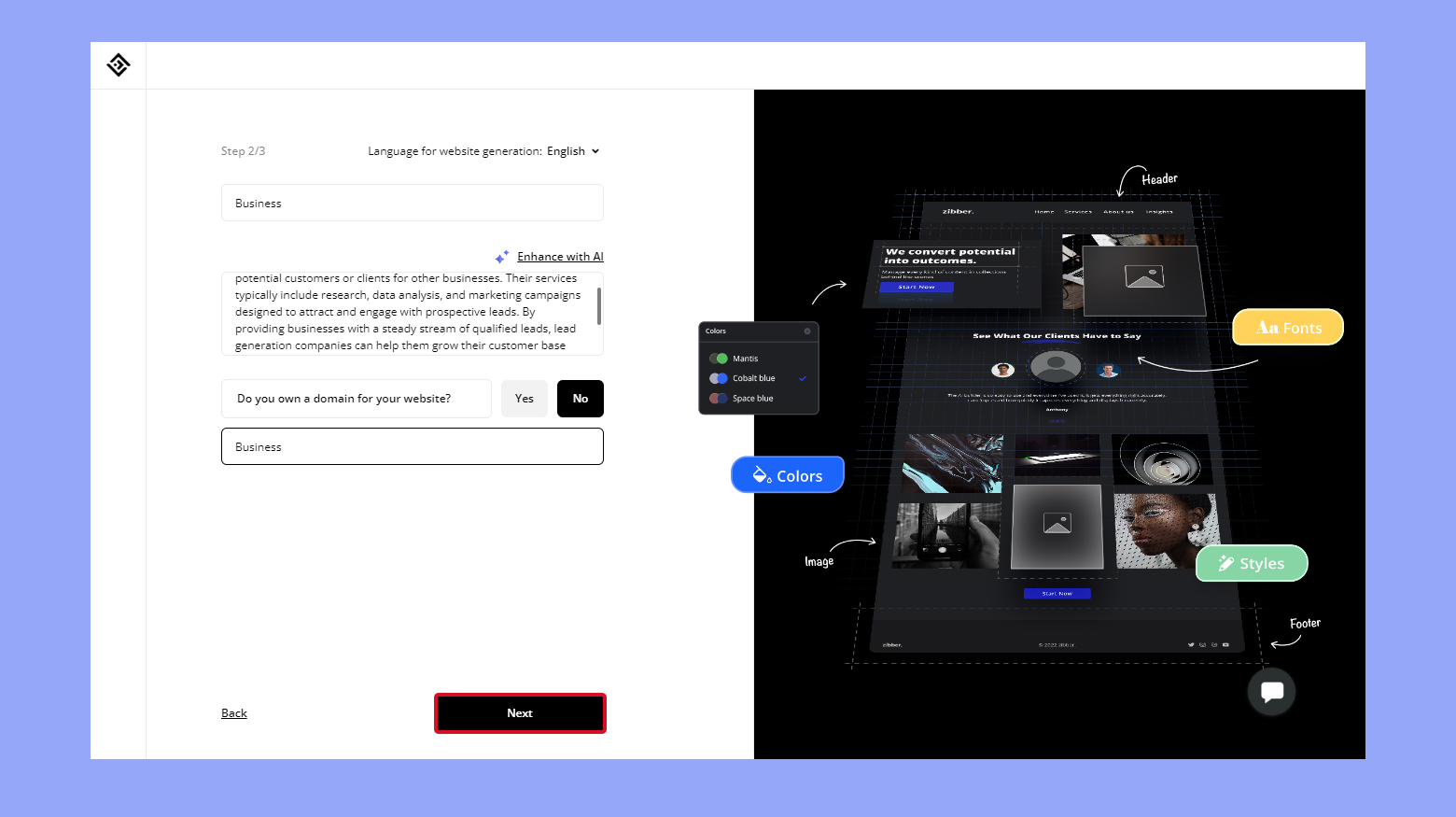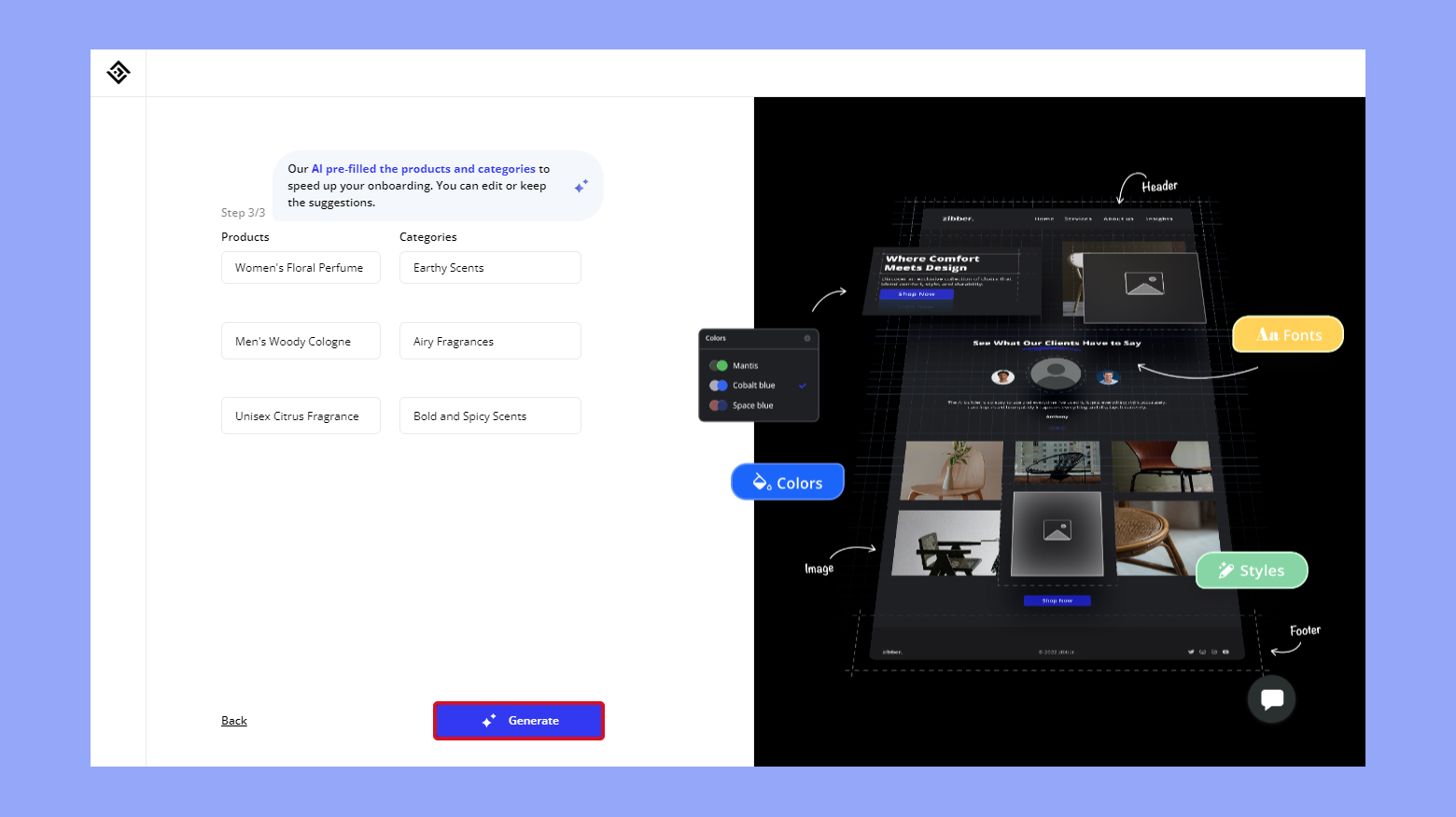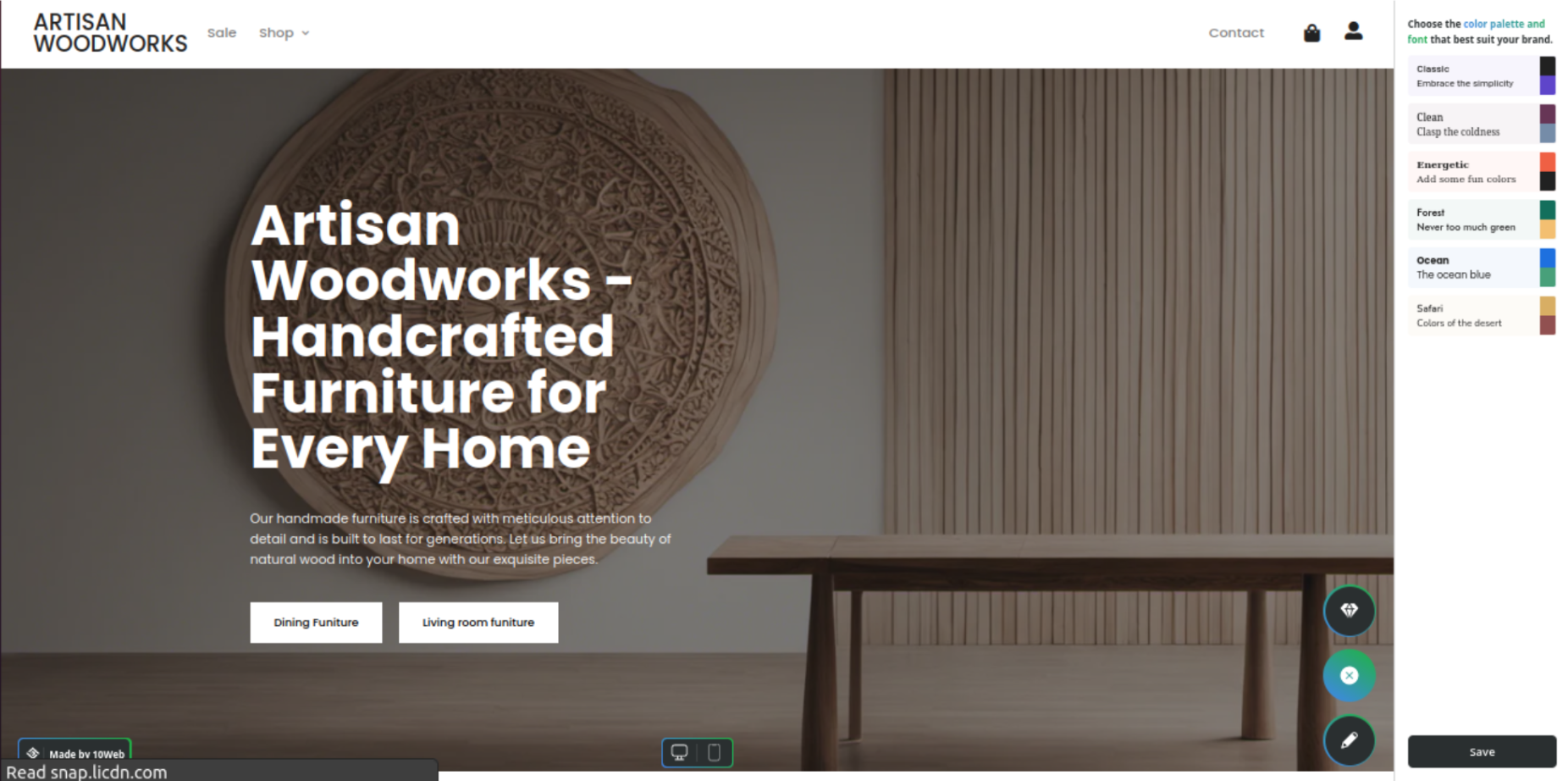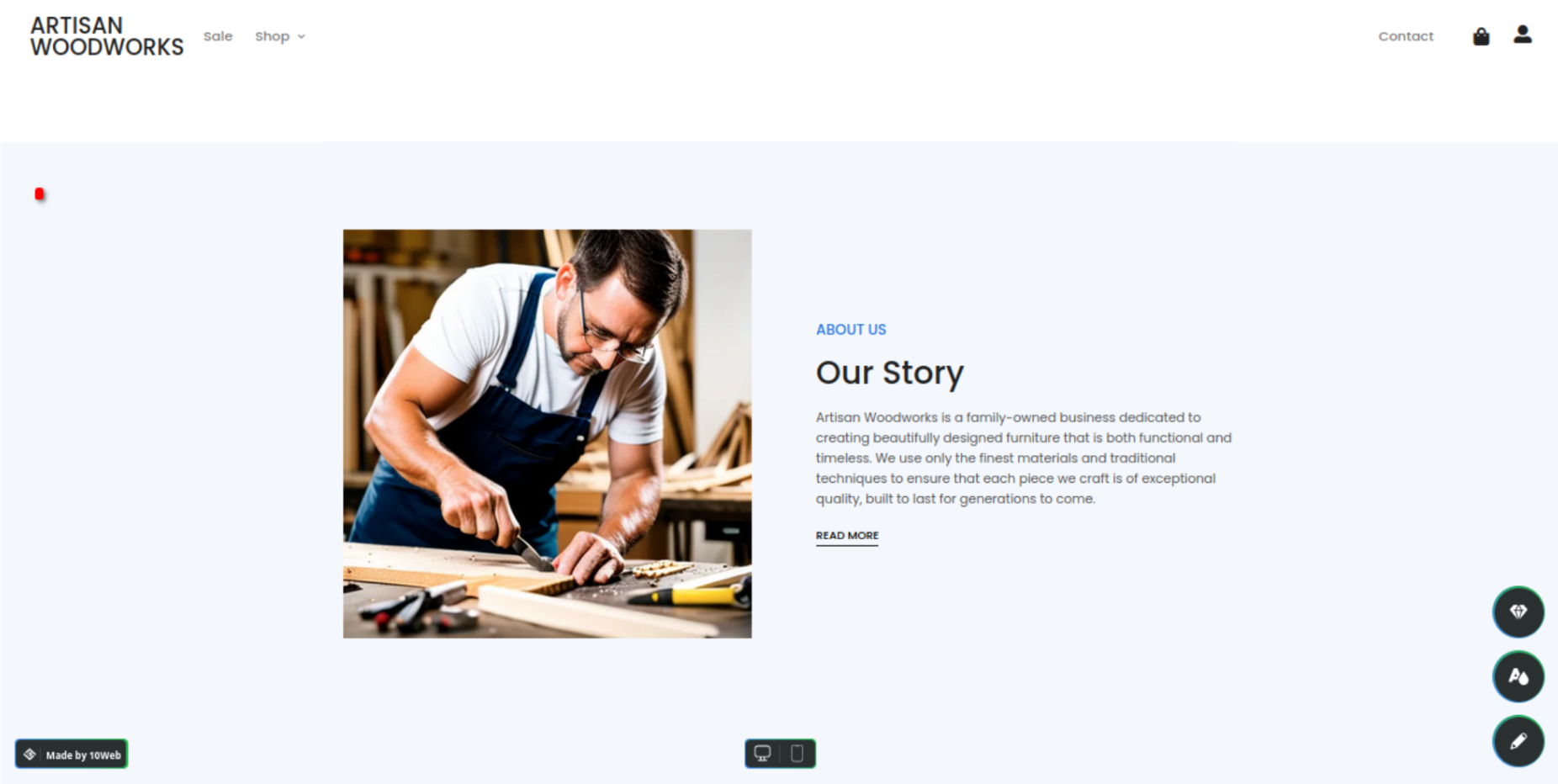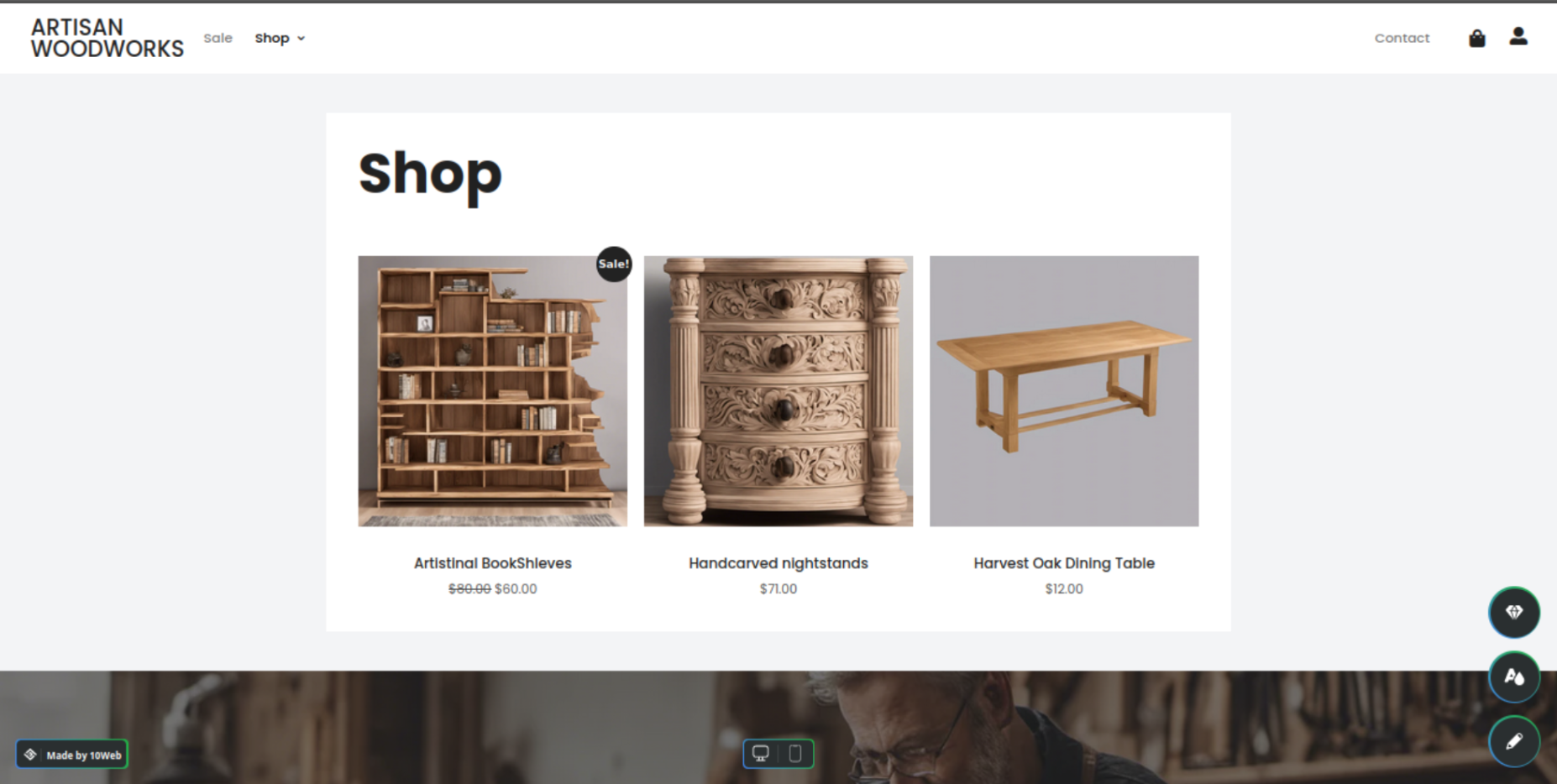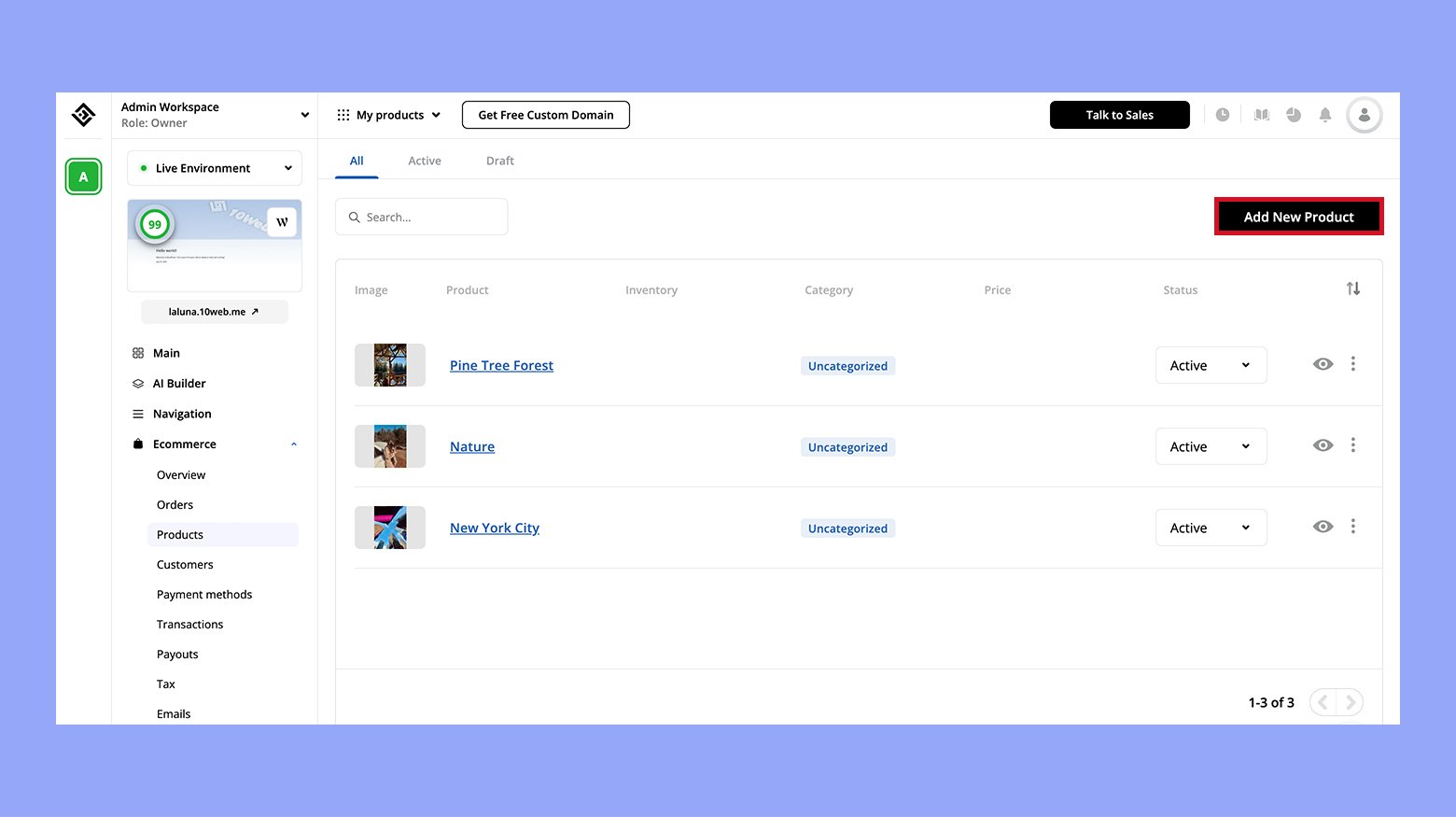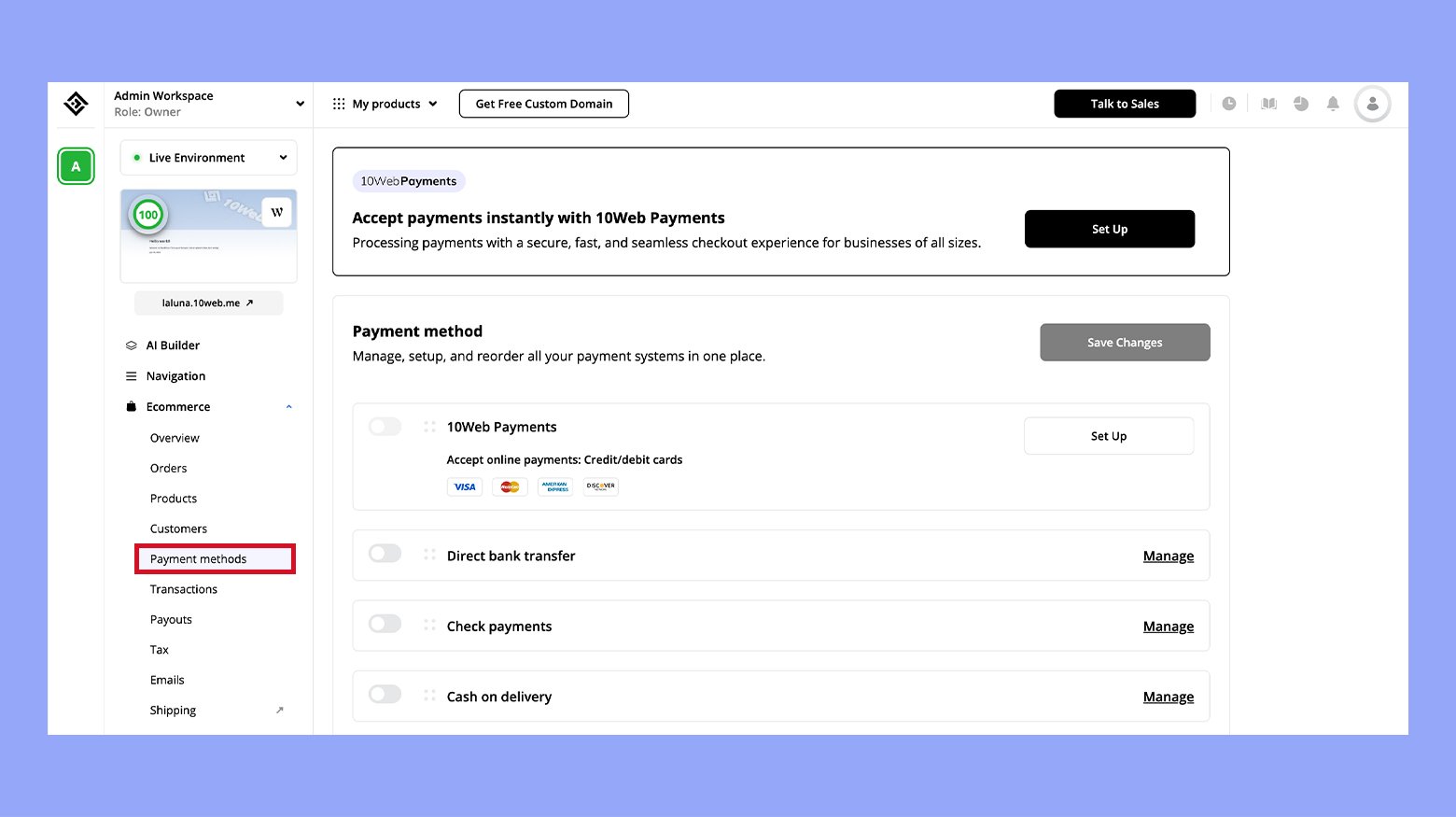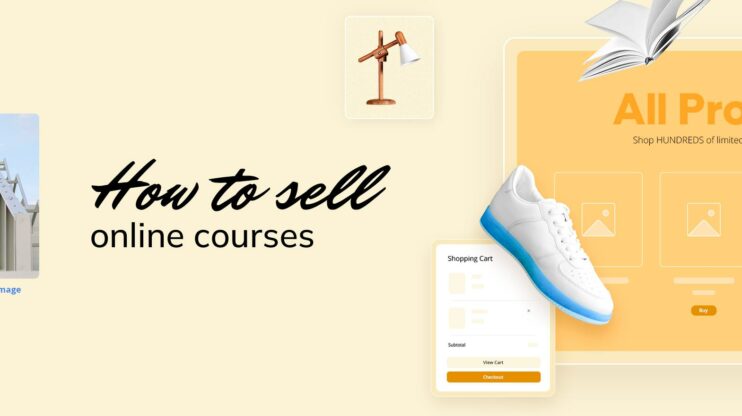The internet has given everyone a chance to become an independent entrepreneur. Whether you’re an aspiring artist, a seasoned collector, or a craftsperson looking to expand your reach, this guide is tailored to help you navigate the online marketplace. We will explore the best platforms to sell your creations and provide essential tips for success. From understanding legalities to maximizing your profits, we’ve got you covered. Apart from that, we have included tips and a step-by-step guide on how to make an online store for handmade items using 10Web AI Ecommerce Website Builder. Let’s embark on this journey to turn your passion into a successful online business.
FAQ
What is the best selling site for handmade items?
Is it legal to sell handmade crafts?
Can I make money selling crafts online?
Is it hard to get approved for Amazon Handmade?

Defining your business objective
Having a clear goal provides clarity, purpose, and vision as you embark on selling handmade items. In this section, we will discuss different types of sellers of handmade items and highlight the unique opportunities associated with each one of them to help you discover the best way to sell handmade items online.
Seller type 1: An artist or a crafter going online
You belong in this category of sellers if you enjoy expressing your artistry by crafting unique handmade items. At the onset, these sellers may not have an existing online store or a robust online presence.
Here are some things you should consider if you’re considering setting up an online store:
- Define your niche: Identify the type of handmade items that you truly have a passion for, taking into account things like the availability of a market, materials, and your skills.
- Choose an appropriate platform to sell: Conduct some research and determine which online platform will best showcase and help you reach your potential customers.
- Set competitive prices: Consider factors like the cost of raw materials, demand, and other costs, such as labor, when pricing your handmade items.
- Conduct thorough research about shipping carriers, costs, and
options: A significant part of learning how to sell handmade items online involves figuring out how your handmade items will safely reach your customer.
Seller type 2: Collector or a restorer who looks to resell online
Collectors and restorers are good at identifying hidden treasures in old or neglected items in junkyards, scrap yards, and antique shops.
Apart from your love for vintage and handmade treasures, there are many factors to consider. Here are some of them:
- Build a network of sources: A strong network with individuals, stores, and antique dealers makes it easier to source these items.
- Branding and storytelling: Storytelling is a powerful marketing tool when you want to sell handmade items that have been restored.
- Refine your restoration skills: While you figure out how to market and sell handmade items online, it is important that you also hone refurbishment skills.
- Transparency and trust: Ensure that you clearly communicate about the state of your handmade items. It is also important that you create a clear return policy.
- Online presence and market research: Conduct extensive research to find out the best platform to sell your restored handmade items.
Seller type 3: A craftsperson looking to sell via social media
These sellers have a home setup where they actualize their ideas about handmade items before marketing and selling them online through social media platforms.
You can learn how to sell handmade items online using the home-based approach before expanding to other platforms. However, this method of selling handmade items requires consistent engagement and branding. Other factors to consider include:
- Choose the right social media platform: Part of deciding where to sell handmade items online involves choosing the right platform. Different platforms have varying audiences and content.
- Share engaging content: Apart from sharing posts that showcase your products, you should also share content such as the story behind your creations.
- Prompt responses: Respond to messages, inquiries, and comments in a timely manner to increase customer trust and satisfaction.
- Secure payment platform: Choose a reputable and convenient means of payment that also guarantees the safety of your customers.
Current online handmade items market
The current handmade items market is driven by the increasing demand for unique and ethically produced goods, making it a lucrative field for creative entrepreneurs.
Trends within the market
Several key trends are shaping the online handmade items market today:
- Personalization and customization: Consumers are increasingly seeking personalized products, which handmade sellers can provide. It gives them a competitive edge over mass-produced goods.
- Sustainable and ethical products: There is a growing preference for sustainable and ethically produced items, encouraging sellers to highlight their eco-friendly practices.
- Social media influence: Platforms like Instagram and Pinterest are powerful tools for promoting handmade items. They allow sellers to visually showcase their products and engage with potential customers.
- Ecommerce tools and AI integration: The use of AI and ecommerce tools, such as the 10Web AI Ecommerce Website Builder, is making it easier for sellers to create professional online stores and streamline their business operations.
Financial projections of the market
The financial projections for the online handmade items market indicate continued growth:
- Market expansion: The global handmade goods market is expected to see significant growth, driven by increasing consumer interest in unique products.
- Revenue growth: The online segment of the handmade market is projected to grow steadily, with more consumers turning to online platforms for their shopping needs.
- Investment in technology: Investments in ecommerce technology and digital marketing are expected to further boost the market, making it more accessible for sellers.
Specialized segments of the market
The online handmade items market includes several specialized segments catering to specific consumer needs and preferences:
- Handcrafted jewelry and accessories: This segment is popular among consumers looking for unique pieces, with a strong presence on platforms like Amazon Handmade.
- Vintage and restored items: Sellers who specialize in vintage and restored handmade items cater to a niche market of collectors and enthusiasts.
- Art and home decor: Handmade art and home decor items are in demand for their aesthetic appeal, making them a significant segment of the market.
- Custom clothing and apparel: Custom-made clothing and apparel are gaining popularity as consumers seek personalized fashion items that reflect their individual styles.
By understanding these trends, financial projections, and specialized segments, sellers can better navigate the dynamic online handmade items market and capitalize on the opportunities it presents.
Recommendations
Understanding your specific role in the market will help you to set clear goals and plan your strategies accordingly.
- Creating your own online store is a great option as it allows you to maintain control over branding, pricing, and direct interaction with your customers. Platforms like the 10Web AI Ecommerce Website Builder can help you set up a professional store quickly and efficiently.
- Online marketplaces like Etsy and eBay are ideal as they provide access to a large customer base and offer specialized categories for various handmade items. These platforms make it easier to find buyers interested in unique and one-of-a-kind products.
- Leveraging social media platforms like Instagram and Pinterest is essential for showcasing handmade items visually and engaging with your audience. Social media offers a direct way to interact with potential buyers and share the stories behind your creations.
On a final note, we recommend you establish a website as it enhances your brand’s credibility and provides a centralized platform for customers to explore your products.
Option 1: Building an online store (best for seller types 1 and 2)
There are many options to consider when figuring out where and how to sell handmade items online. However, nothing comes close to the opportunities, autonomy, and reliability provided by setting up your own store. In this section, we are going to highlight how you can leverage the power of AI through the
10Web AI Ecommerce Website Builder.
Benefits
- Control over personal branding and imaging: Setting up your own online store for selling handmade items offers a level of control over your brand and business that is often unmatched by online marketplaces and social media platforms.
- Increased market reach: Setting up your own online store allows you to access a global audience regardless of their geographical location.
- Work on your own terms: Having your own store allows you to sell handmade items on your terms by setting your return policies, shipping options, and customer service standards.
- Data for informed decision-making: You can access data and with the right analytic tools, you can leverage it to continually refine your offerings and improve your store.
- Keep all your sales revenue: Most online marketplaces require you to pay a commission for each sale that you make. However, with your own store, you get to keep almost all your sales revenue.
Limitations
- Initial Setup Cost: Building a professional online store requires an initial investment for web
design, hosting, and ecommerce platforms. - Competition: Standing out in a crowded online marketplace can be challenging, requiring
continuous effort in customer engagement. - Ongoing Maintenance: An online store requires regular updates and maintenance to ensure smooth operation and protect against cyber threats.
- Customer Trust: Building customer trust takes time, especially for new online stores without an established reputation.
Step-by-step guide on how to make an online store
In this section, we will show you how you can leverage the power of artificial intelligence to simplify the process of setting up your store.

Looking to sell online?
Create your custom online store in minutes with 10Web AI Ecommerce Website Builder and take your business online.
Pick and register a domain name and hosting partner
A domain name is the equivalent of the physical address of your house. A domain name allows users to find your website on the internet. You should choose
a domain name that is unique, memorable, concise and aligns with your business name.
You can try finding and buying a domain name for your store with 10Web Pro Plans.
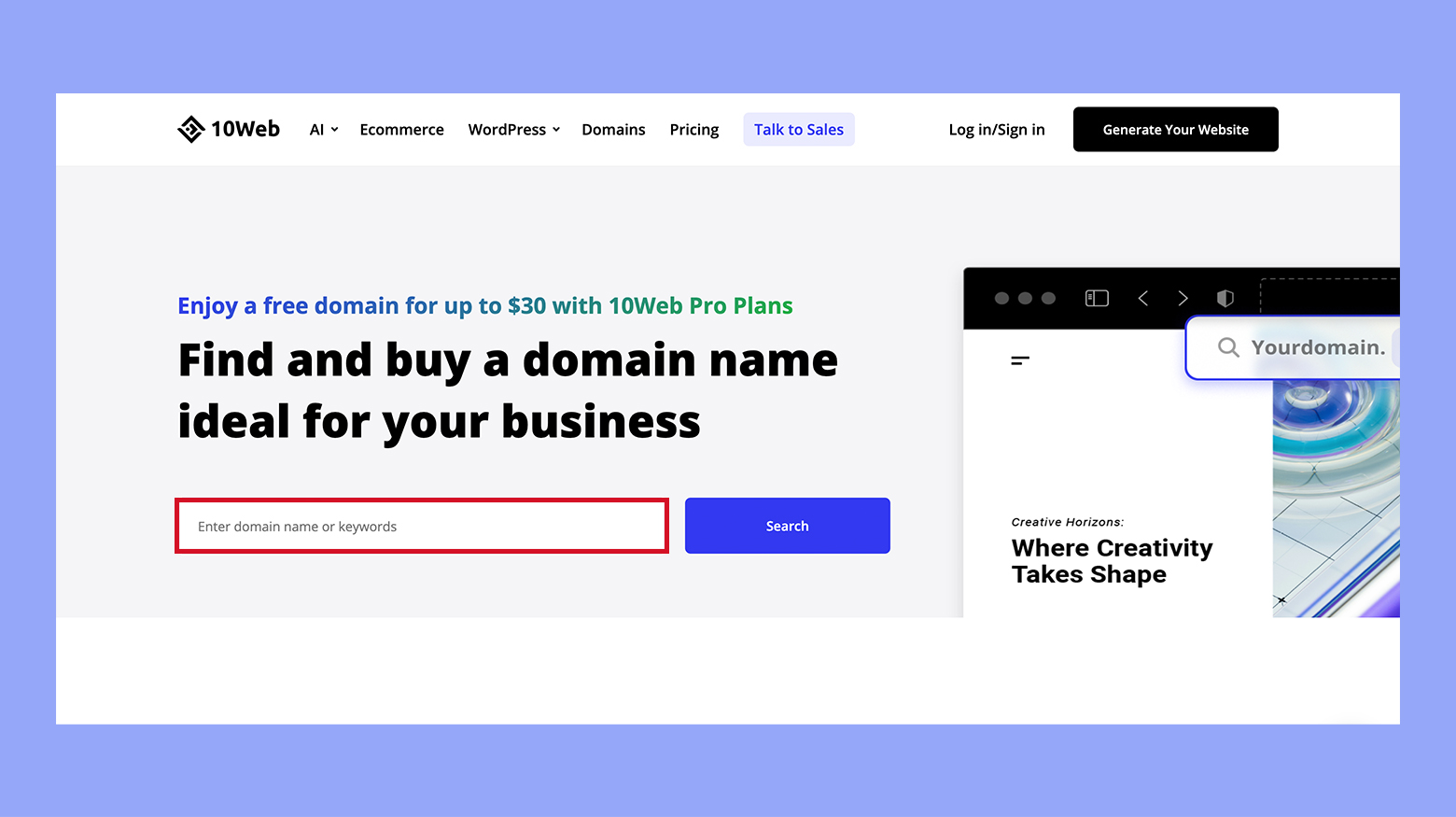
Remember that you can quickly generate catchy and memorable names for your handmade items business with AI for free using
10Web AI Business Name Generator.
A hosting service is the equivalent of a rented house. In this case, you’re renting space on a server to store the files and data that make up your website. Choose a hosting provider with a strong reputation for reliability and high uptime such as 10Web.
Design your online store
10Web AI Website Builder is a powerful website builder that allows you to build a professional website with the power of AI. In this section, we are going to illustrate how you can build a store using 10Web AI Ecommerce Website Builder.
- Head to the 10Web AI Ecommerce Website Builder page to build a handmade furniture store.
- Click on the Generate your website button or log in to your dashboard.

- Select Proceed to create a new website with AI.

- Choose the second option to create a website with an online store.

- Specify that your business type is to establish an online store, for example a handmade furniture items store.

- Provide your store or business name and offer a brief description of your handmade items business. Optionally, input keywords and let the AI engine transform them into a compelling description.

- Enter the names of the initial three products you intend to sell in your online handmade items store, along with their respective categories.
- When done, click Finalize, and wait for 10Web to generate your site.

- Once your site is generated, preview it and make any necessary adjustments using the user-friendly tools provided by 10Web.
- Wait for the 10Web AI Website Builder to craft your handmade items store. This process may take a moment or two.
- Your handmade furniture store is now set up, complete with prepopulated content and images. It features key sections such as the Homepage, About Us, New Arrivals and Shop.




- List your products and descriptions: Curate your product listing using high-quality images and clear descriptions.

- Set up payment and shipping: Integrate the payment gateways you have chosen with your handmade items store.

- Publish your online store: Once you feel that your site is ready, launch your store and make it public.
- Monitor and improve: Finally, when your handmade items store is live, monitor your store’s performance, track sales, and analyze customer behavior. Collect some data and use it to make improvements, optimize your handmade items, and refine your marketing strategy.
5 tips to promote your online store
Learning how to sell handmade items online does not end once you publish your store online. You should also find creative ways to promote your site and generate new leads consistently. Here are awesome tips you can use to increase the visibility of your handmade items store and reach a wider audience:
- Focus on Search Engine Optimization: This is by far one of the most effective ways to drive traffic to your online store. Start by conducting keyword research and use these words in your product titles, descriptions, and meta tags.
- Leverage content marketing and blogging: Content marketing is a powerful strategy for building an audience. A blog is a great way to share content about your handmade items, craftsmanship, and behind-the-scenes content.
- Use social media channels: Social media platforms allow you to engage with your audience directly. You can also share visual content of your handmade items, highlighting details and unique features to captivate your audience.
- Build an email list: You can send regular newsletters with updates on new products, promotions, and exclusive offers to interested customers.
- Encourage customer reviews and testimonials: Encourage satisfied customers to leave reviews and testimonials to build trust with potential buyers.

Looking to sell online?
Create your custom online store in minutes with 10Web AI Ecommerce Website Builder and take your business online.
Option 2: Selling in marketplaces (best for seller types 1 and 2)
Figuring out how to sell handmade items online has its fair share of challenges, from establishing an online presence to managing production and shipping logistics. Online marketplaces exist to lessen the struggle of learning how to market and sell handmade items online.
Benefits
- Access to an established audience: Unlike your personal store, where build an audience from scratch, online marketplaces already have a base of potential customers.
- Fewer market efforts are required: Marketplace platforms such as Etsy already attract and market themselves to millions of users worldwide. Therefore, selling on marketplaces is much easier and requires less marketing effort.
- Easier and safer payment processing: Handling transactions can be a real mess, especially with the ever-existing cyber threats. Many marketplaces offer secure and streamlined payment processing. This can save you the costs and headache of setting up your own payment systems.
- Marketplaces take care of shipping and delivery for you: Shipping and delivering are tough topics, especially when you’re still mastering how to sell handmade items online. However, most marketplaces take care of things like shipping, delivery, returns, and exchanges.
Limitations
- Marketplaces charge high fees and commissions: This can be anywhere between 20% to 40% percent on every sale you make. This can really cut off most of your sales revenue.
- Limited branding and customization: There is only so much that you can do on online marketplaces to create a unique brand due to limitations. This can be a challenge if you want to create a unique handmade items business.
- Lots of competition: Online marketplaces can be both a blessing and a curse. While there is an already built audience of customers, there are also hundreds of sellers with similar offerings. Standing out among other sellers can be a challenge.
- Limited access to customer data: While most marketplaces have improved this in recent years, most marketplaces still get to keep a huge junk of data. This deprives you of the crucial data for understanding your customers and making key decisions.
Top 5 places for selling handmade items online
1. Etsy
Etsy is an American ecommerce company focused on handmade or vintage items and craft supplies. Selling handmade items on Etsy gives you access to a vibrant community of over 30 million independent crafters, artists, and collectors.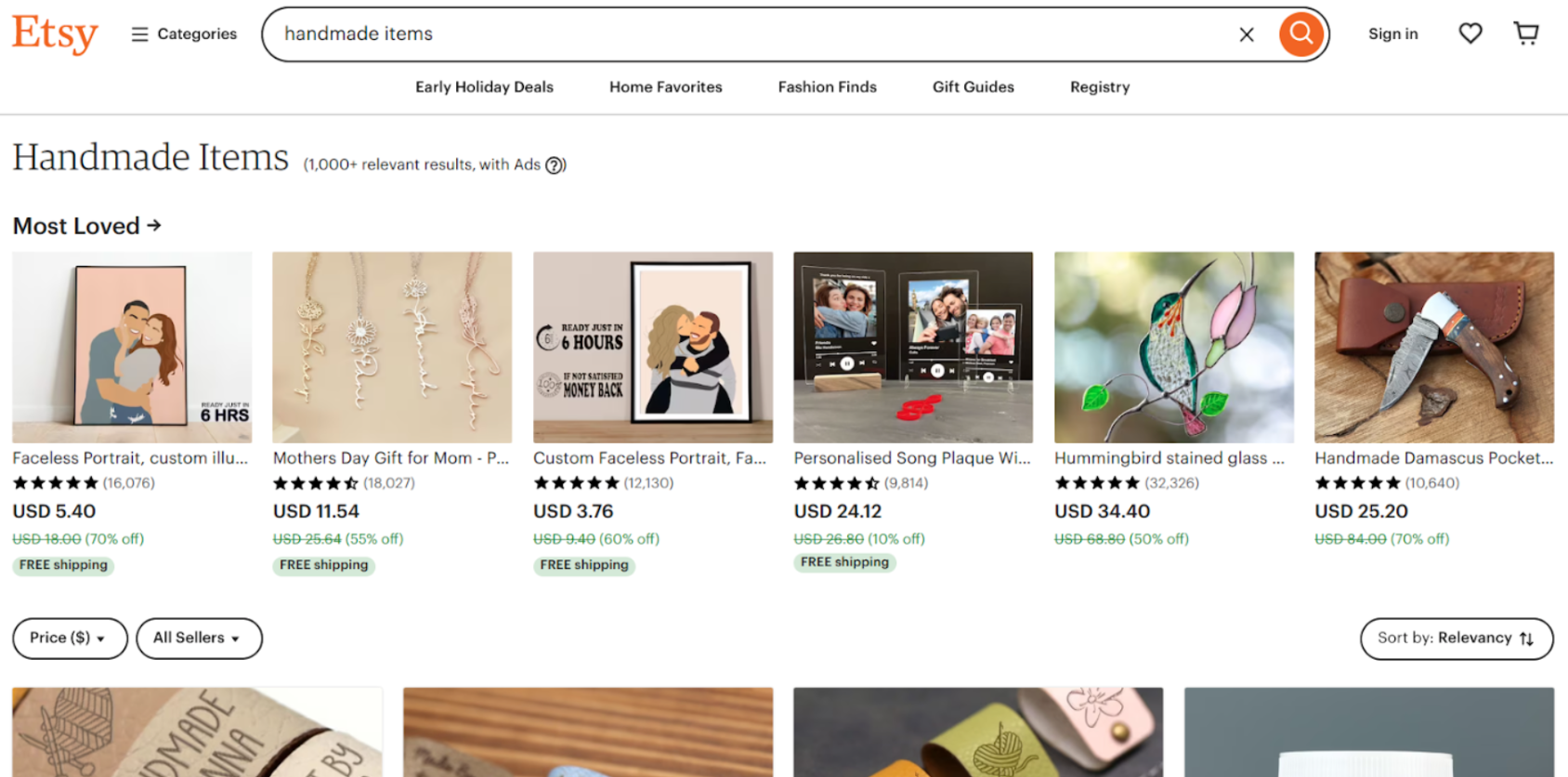
2. Amazon Handmade
Amazon Handmade. is a marketplace integrated into the giant ecommerce platform known as Amazon. Amazon Handmade allows sellers to list unique, genuinely handcrafted products created by local artisans and artisans around the world.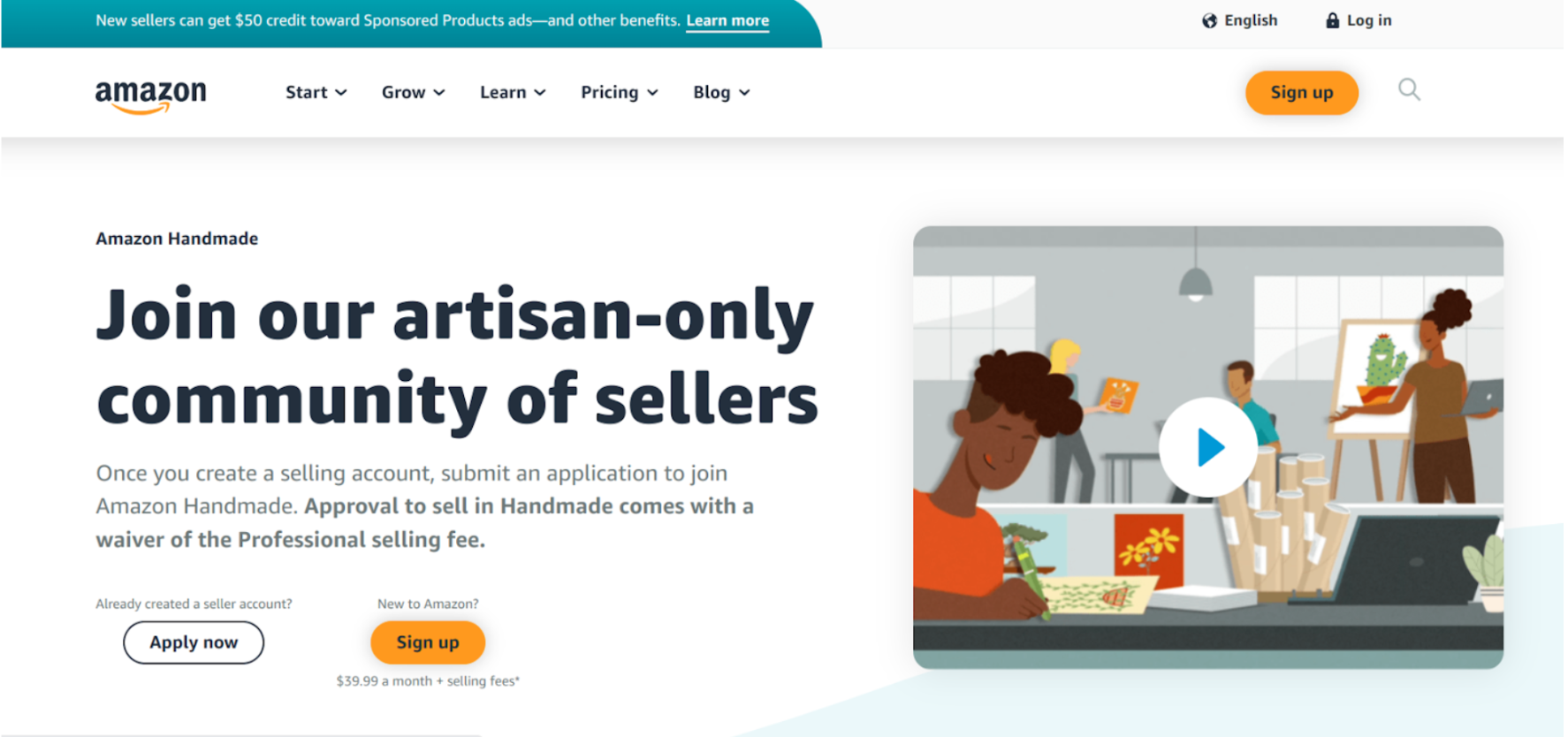
3. eBay
eBay is an online auction and marketplace that simply facilitates the sale of goods between third-party buyers and sellers. Selling handmade items on eBay gives you access to extensive shipping choices and fixed-price listing options.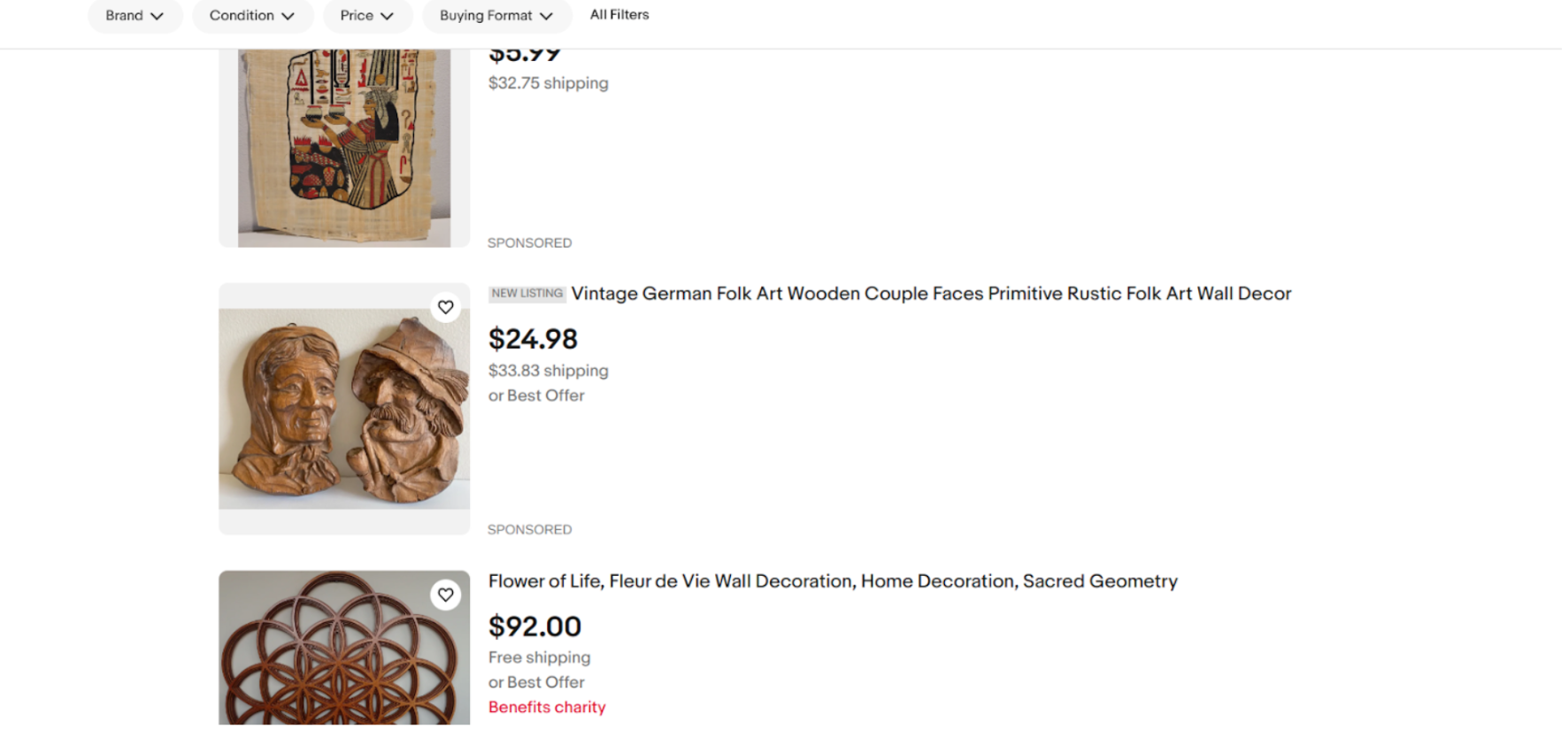
4. Big Cartel
Big Cartel caters to independent artists and creators, providing them with an accessible platform to showcase and sell their unique creations. Big Cartel makes it easy to set up your store and the tools you need, including your own unique storefront where you can showcase goods.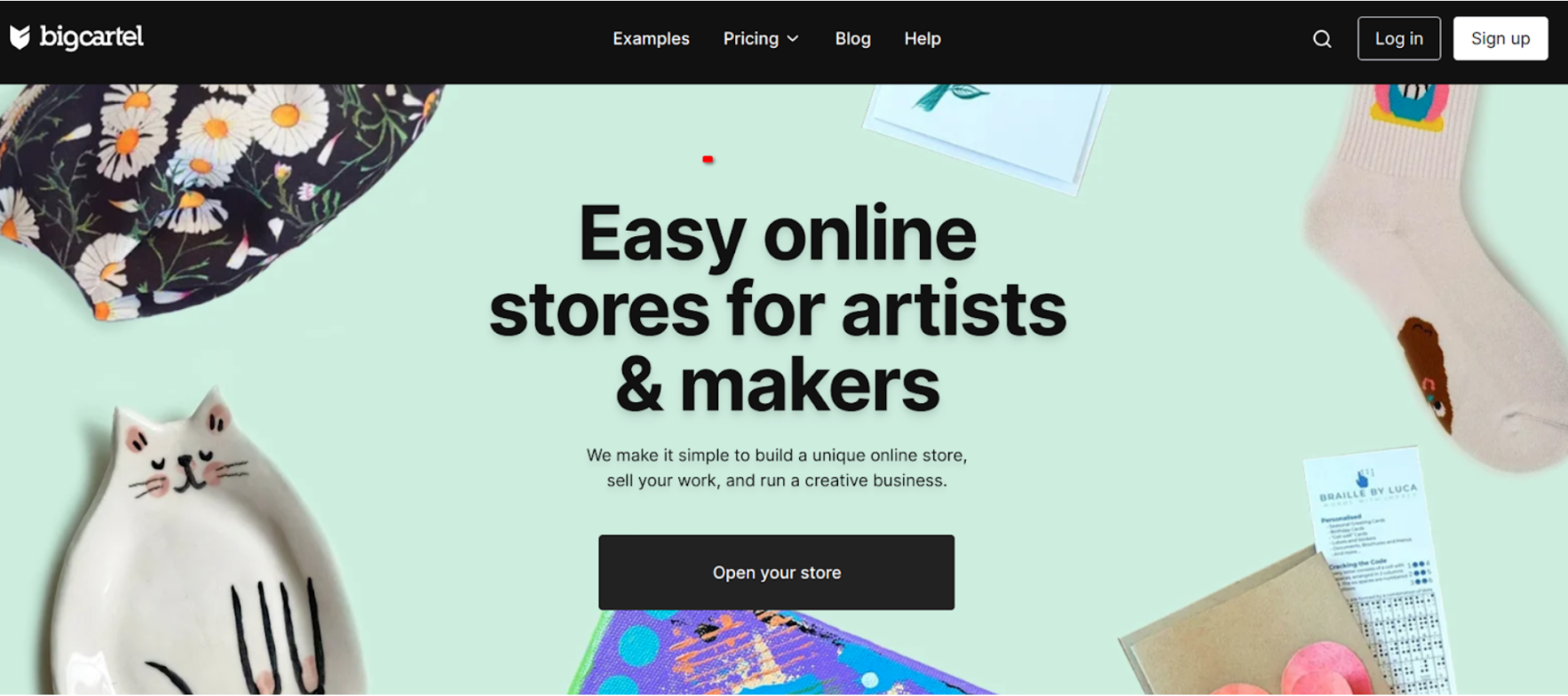
5. Bonanza
Bonanza is an established marketplace that empowers sellers to sell handmade items and other products such as antiques, books, clothing, and accessories. The platform is known for its user-friendly interface and ability to open virtual booths where you can sell your handmade items.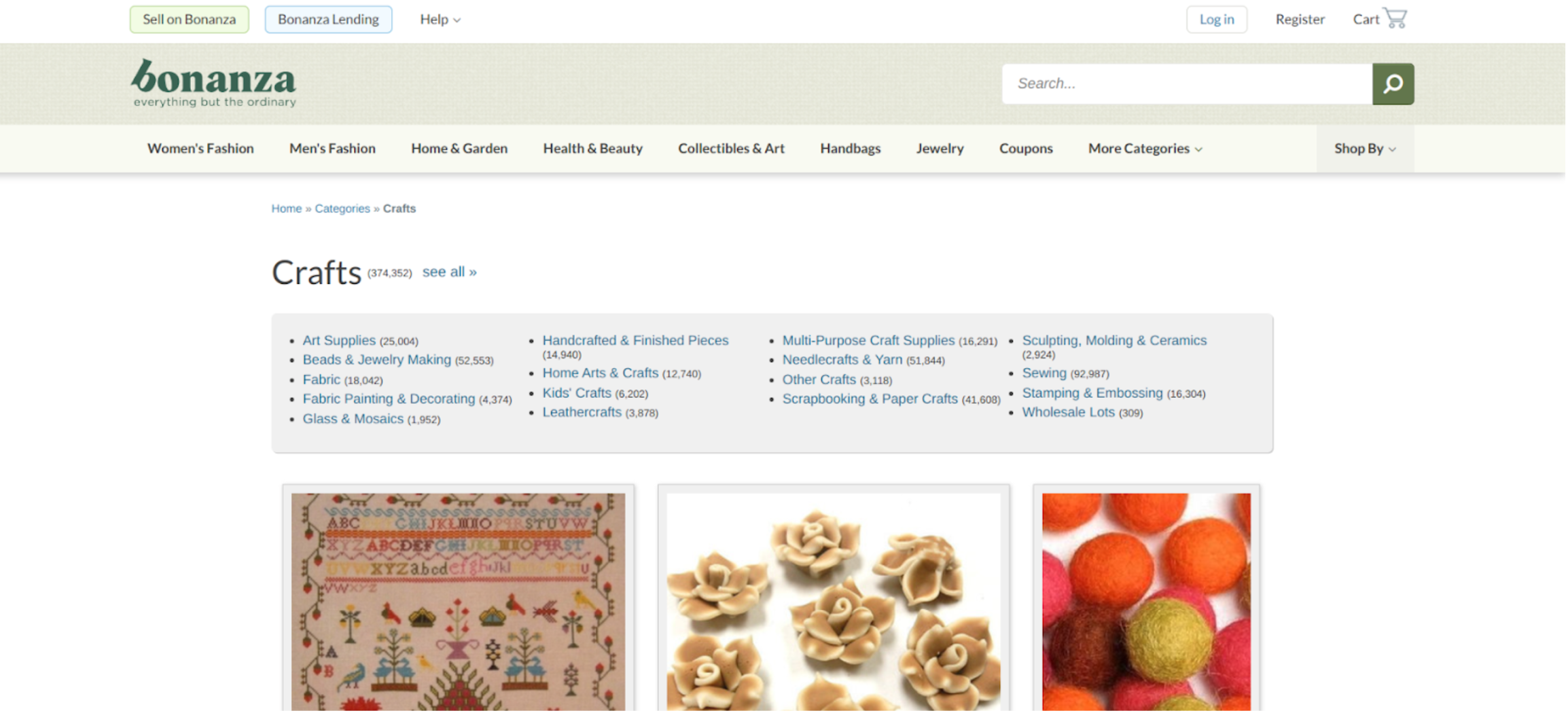
5 tips to consider for success
- Choose the right marketplace: Regardless of how popular a marketplace platform is, ensure that you conduct a research to ascertain that it is the right platform.
- Create a unique and compelling product catalog: There are tens of other businesses selling handmade items on any marketplace. You must craft a compelling product listing to stand out.
- Diversify product range: Selling a single type of handmade item can be catastrophic, especially when customers switch to a more attractive product. On the other hand, providing variety can attract a wider audience and cater to different customer preferences.
- Create an effective pricing strategy: It is important to set prices that help you stay profitable and competitive at the same time. This is why you need an effective pricing strategy.
- Understand commissions and any hidden fees: Marketplaces are not entirely free. Most of them charge sellers a number of fees.
Option 3: Selling on social media (best for seller type 3)
Social media platforms like Facebook, Instagram, and Pinterest have evolved into marketplaces themselves where buyers and sellers can interact like typical marketplace platforms. There is no doubt that selling handmade items in your own store gives you autonomy. However, the power of social media should not be underestimated. This is especially true when you’re still getting to the bottom of how to sell handmade items online.
In this section, we’ll help you choose the right platform and share tips to help you sell handmade items online through social media.
Benefits
- Direct interaction with your audience: Social media platforms allow you to engage with your potential customers directly. You can engage with your audience through chats, comments, and posts. You can directly answer inquiries from customers, engage with them, and receive feedback in real-time.
- Access to a global audience: Social media platforms allow you to connect with anyone from any part of the world. With the right strategy, you can easily market and sell handmade items globally as long as you have the shipping capability.
- Influencer partnerships: Influencers are regular users on social media platforms who have huge engagements and social media following. They can influence the opinions, behaviors, and purchase decisions of other users on these platforms. You can partner with influencers to increase your brand visibility.
- Personalized marketing options: Social media platforms like Facebook offer comprehensive ad targeting options. It allows you to run advertisements that are more likely to interest certain groups.
Limitations
- Policies and terms and conditions: Any engagements you make on social media platforms are subject to the guidelines of that platform.
- Social media is very competitive: Social media platforms are filled with copycat businesses competing for attention. It requires more effort and marketing for your handmade items business to stand out.
- Algorithms change and shadow banning: Social media algorithms determine who sees and engages with your handmade items. Some changes in algorithms can affect the visibility of your items on these platforms.
- Limited branding and customization options: Social media platforms are primarily designed for social interactions. Therefore, they lack extensive features that can allow you to build a unique brand when compared to your own dedicated online store.
- Payment security concerns: Most users may be skeptical about sharing their payment details when purchasing through social media platforms due to the increased cases of cyber-attacks on social media platforms.
Tips for selling handmade items via social media
- Use hashtags and engaging captions strategically: Hashtags can help you improve the visibility of your posts. Research and use relevant tags on every post you make, or create unique hashtags and encourage users to use them. Good captions can also help catch the attention of users.
- Encourage customer testimonials: Ask customers who like your handmade items to share feedback and testimonials on their pages using hashtags. This can improve your credibility and reach.
- Invest in high-quality visuals: Images about your products can have a big influence on the buyer’s decision. Consider using professional photography and editing tools to showcase different angles and details of your handmade items.
- Use targeted advertising: Social media platforms like Facebook offer targeted advertising that allows you to reach the right audience, increasing the likelihood of conversions and sales. You can use different strategies, such as location targeting and behavior targeting.
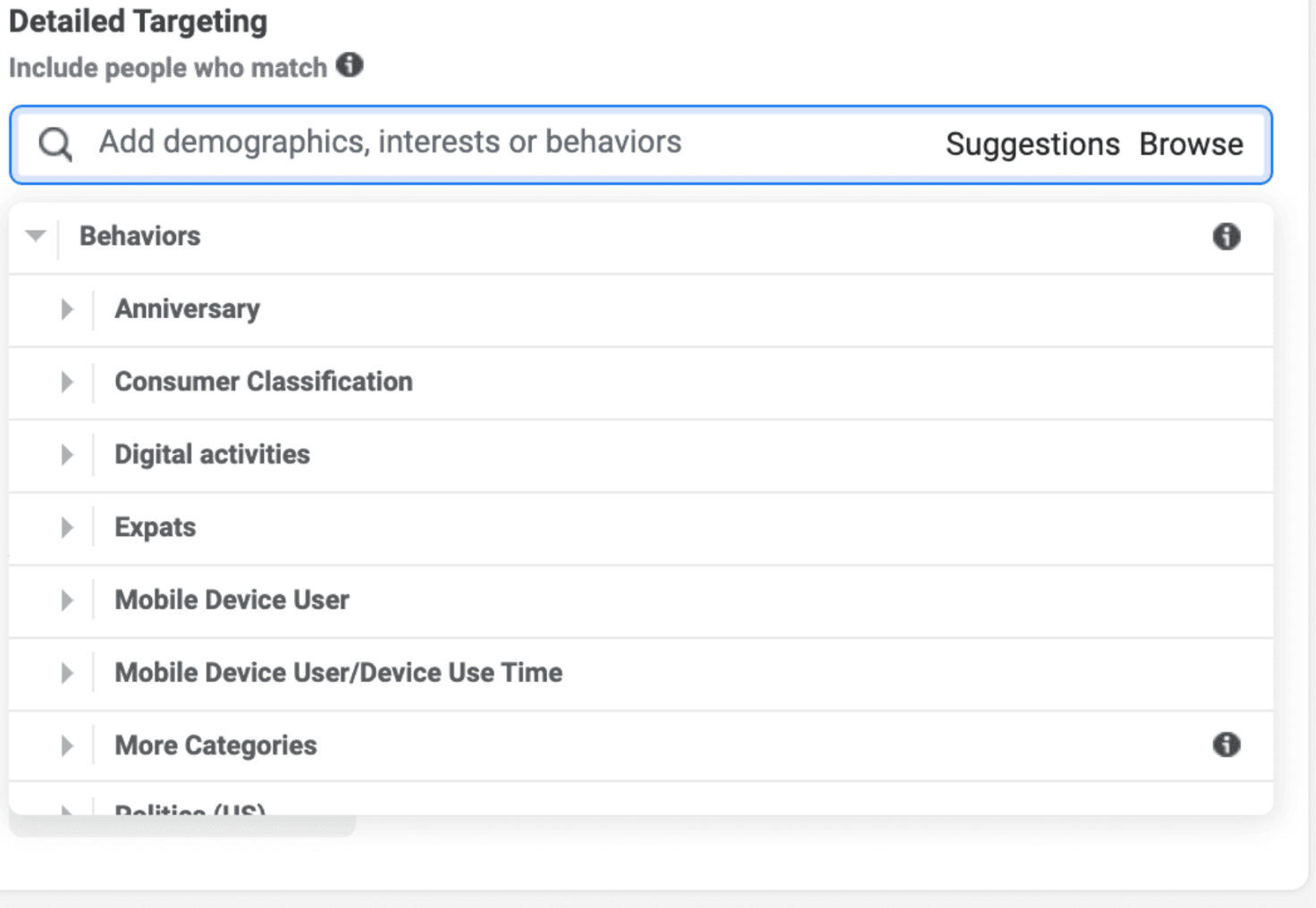
Conclusion
With the growing appreciation for sustainable and ethically produced goods, the demand for handmade items crafted with lots of love, care, and attention to detail is not likely to slow down anytime soon. So whether you’re an experienced artist or an amateur just learning how to sell handmade items online, you can capitalize on this trend to build a sustainable online handmade items business. Remember that when setting up your online store, you can embrace the power of 10Web AI Website Builder to avoid the complexities of the web design process. With just a few clicks and details about your handmade items business, your site will be generated in a matter of minutes.



